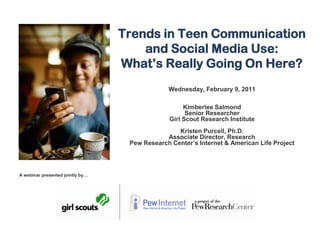Pew internet girl_scout_webinar
- 1. Trends in Teen Communication and Social Media Use: WhatŌĆÖs Really Going On Here? Wednesday, February 9, 2011 Kimberlee Salmond Senior Researcher Girl Scout Research Institute Kristen Purcell, Ph.D. Associate Director, Research Pew Research CenterŌĆÖs Internet & American Life Project A webinar presented jointly byŌĆ”
- 2. Highlight findings from two recent studies: ŌĆō Pew InternetŌĆÖs Teens and Mobile Phones, April 2010. Joint study with the University of Michigan, available at pewinternet.org. ŌĆō Girl Scout Research InstituteŌĆÖs WhoŌĆÖs That Girl: Image and Social Media Survey, November 2010. Available at girlscouts.org.
- 3. Pew Internet Teens and Mobile Phones Study ŌĆó 800 teens ages 12 to 17 and a parent or guardian were contacted by landline or cellular telephone in a nationally representative RDD survey conducted from June to September 2009 ŌĆó 9 focus groups in four cities with middle and high school aged teens (ages 12-18) conducted in June and October 2009 ŌĆó Joint project of the Pew Research CenterŌĆÖs Internet & American Life Project and the University of Michigan. Co-authors are Amanda Lenhart, Rich Ling, Scott Campbell and Kristen Purcell. ŌĆó Comparative adult data is from the most recent Pew Internet tracking surveys 3
- 4. Teens are the heaviest internet users Teen data Sept 2009 Adult data Nov 2010
- 5. There remains a digital divide Teen internet High-speed (broadband) access in the home is also access is highest most common in white, among teens highly educated and more withŌĆ” affluent households ’āśWhite parents ’āśCollege- educated High-speed parents connection means greater overall ’āśAnnual engagement in online household activities, particularly incomes above activities like social $50,000 media
- 6. Teen cell phone use is on the rise Teen data Sept 2009 Adult data Nov 2010
- 7. Teen cell phone use varies by age 31% of 8-10 year-olds have a cell phone, according to a January 2010 Kaiser Family foundation study, available at kff.org.
- 8. Teens and young adults are the heaviest SNS users SURPRISE! Among teens, girls are no more likely than boys to use SNS. But among adults, women use SNS at higher rates than men. Teen data Sept 2009 Adult data Nov 2010
- 9. For teens, Twitter is less popular than SNS THE BIEBER EFFECT? 14-17 year-old girls are the heaviest teen Twitter users. 13% of this group use Twitter, compared with 7% of boys the same age. Teen data Sept 2009 Adult data Nov 2010
- 11. Girl Scout Research Institute WhoŌĆÖs that Girl? Image and Social Media
- 12. METHODOLOGY ’üČ Nationwide online survey ’üČ Conducted with 1,026 girls ages 14-17 ’üČ Survey fielded June 2010 ’üČ Girls were required to have a social network profile to participate
- 13. Despite popular perception, social networks are not necessarily a ŌĆ£girlŌĆÖs best friend.ŌĆØ ’üČ While many girls use social networking sites regularly, most girls still prefer face to face communication. ’üČ 92% of girls would give up all their social networking friends to keep their best friend.
- 14. On social networks, a girlŌĆÖs image is not always what it seems. ’üČ 74% of girls agree that ŌĆ£most girls my age use social networking sites to make themselves look cooler than they are.ŌĆØ ’üČ Girls downplay several positive characteristics of themselves online, like their intelligence and efforts to be a good influence. ’üČ Girls with low self-esteem are more likely to say their online image doesnŌĆÖt match their in person image.They are also more likely to report negative experiences on social network sites.
- 15. Girls have good intentions when it comes to safe social networking behavior but donŌĆÖt always act on them. ’üČ 85% of girls have talked with their parents about safe social networking behavior, but half (50%) admit they arenŌĆÖt as careful as they should be. ’üČ Many girls are concerned about the potential negative consequences of their online behavior and content.
- 16. GirlsŌĆÖ emotional safety and reputations are at risk online. ’üČ 68% of girls have had a negative experience on a social networking site. The upside to social networking includes better relationships and connections to causes girls care about. ’üČ 56% of girls agree that social networks help them feel closer and more connected to their friends. ’üČ 52% have gotten involved in causes they care about through a social network.
- 17. Conclusions/Tips: ’üČ Social networks are here to stay, but they arenŌĆÖt necessarily the devil. ’üČ Have very specific conversations with your children about safe social networking. ’üČ Educate yourself about social networks and become comfortable using them. ’üČ Promote self-confidence and healthy self-esteem whenever possible. More information can be found at www.girlscouts.org/research
- 18. Questions?


















